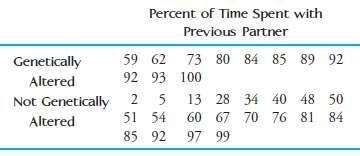Question
The article Genetic Tweak Turns Promiscuous Animals Into Loyal Mates (Los Angeles Times, June 17, 2004) summarizes the results of a research study that appeared
The article Genetic Tweak Turns Promiscuous Animals Into Loyal Mates (Los Angeles Times, June 17, 2004) summarizes the results of a research study that appeared in the June 2004 issue of Nature. In this study, 11 male meadow voles who had a single gene introduced into a specific part of the brain were compared to 20 male meadow voles who did not undergo this genetic manipulation. All of the voles were paired with a receptive female partner for 24 hours. At the end of the 24-hour period, the male was placed in a situation where he could choose either the partner from the previous 24 hours or a different female. The percentage of the time during a 3-hour trial that the male spent with his previous partner was recorded. The accompanying data are approximate values read from a graph that appeared in the Nature article. Do these data support the researchers€™ hypothesis that the mean percentage of the time spent with the previous partner is significantly greater for genetically altered voles than for voles that did not have the gene introduced? Test the relevant hypotheses using a = .05.

Percent of Time Spent with Previous Partner Genetically 59 62 73 80 84 85 89 92 Altered 92 93 100 Not Genetically 5 13 28 34 40 48 50 Altered 51 54 60 67 70 76 81 84 85 92 97 99 2.
Step by Step Solution
3.32 Rating (146 Votes )
There are 3 Steps involved in it
Step: 1
alphaa 005n1 11 x1 71273 s1 13879n2 20 x2 4935 s2 27925H0 u1 u2H1 u1 ...
Get Instant Access to Expert-Tailored Solutions
See step-by-step solutions with expert insights and AI powered tools for academic success
Step: 2

Step: 3

Ace Your Homework with AI
Get the answers you need in no time with our AI-driven, step-by-step assistance
Get Started


